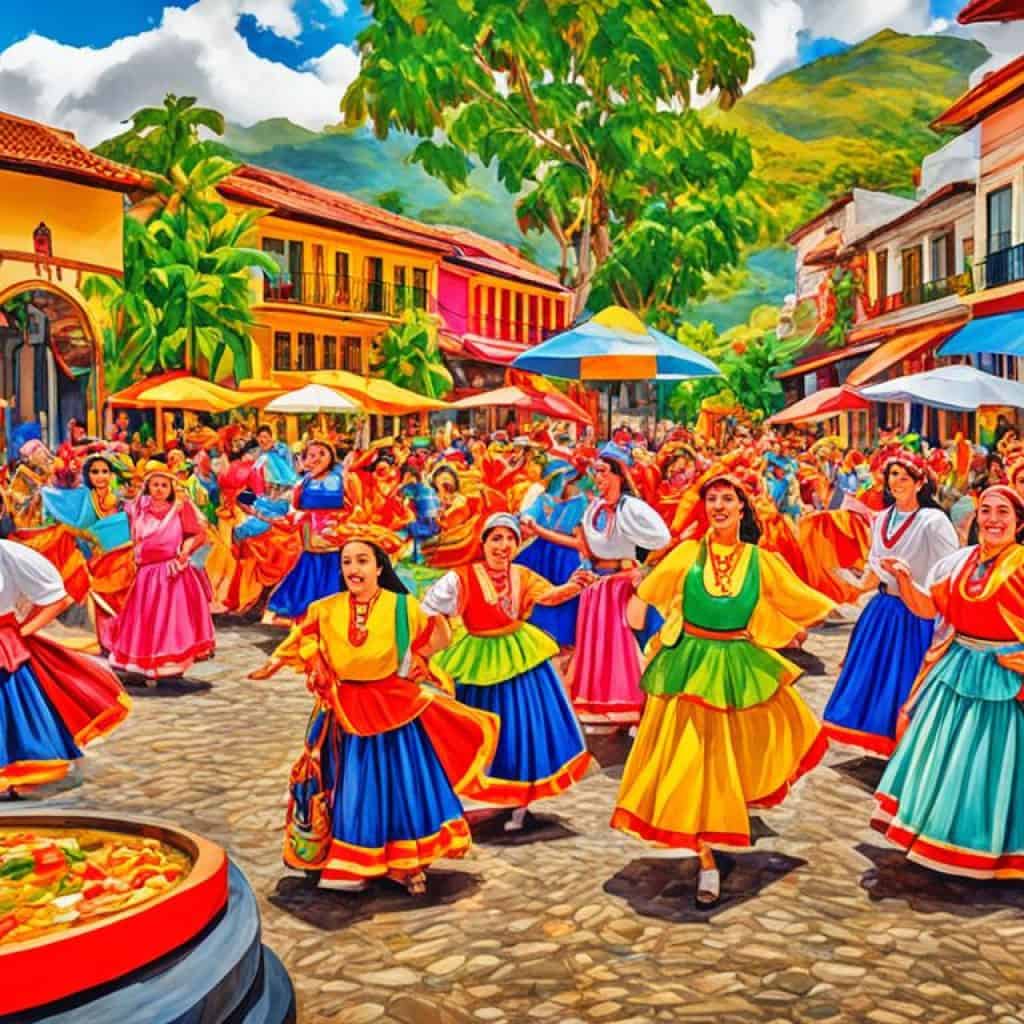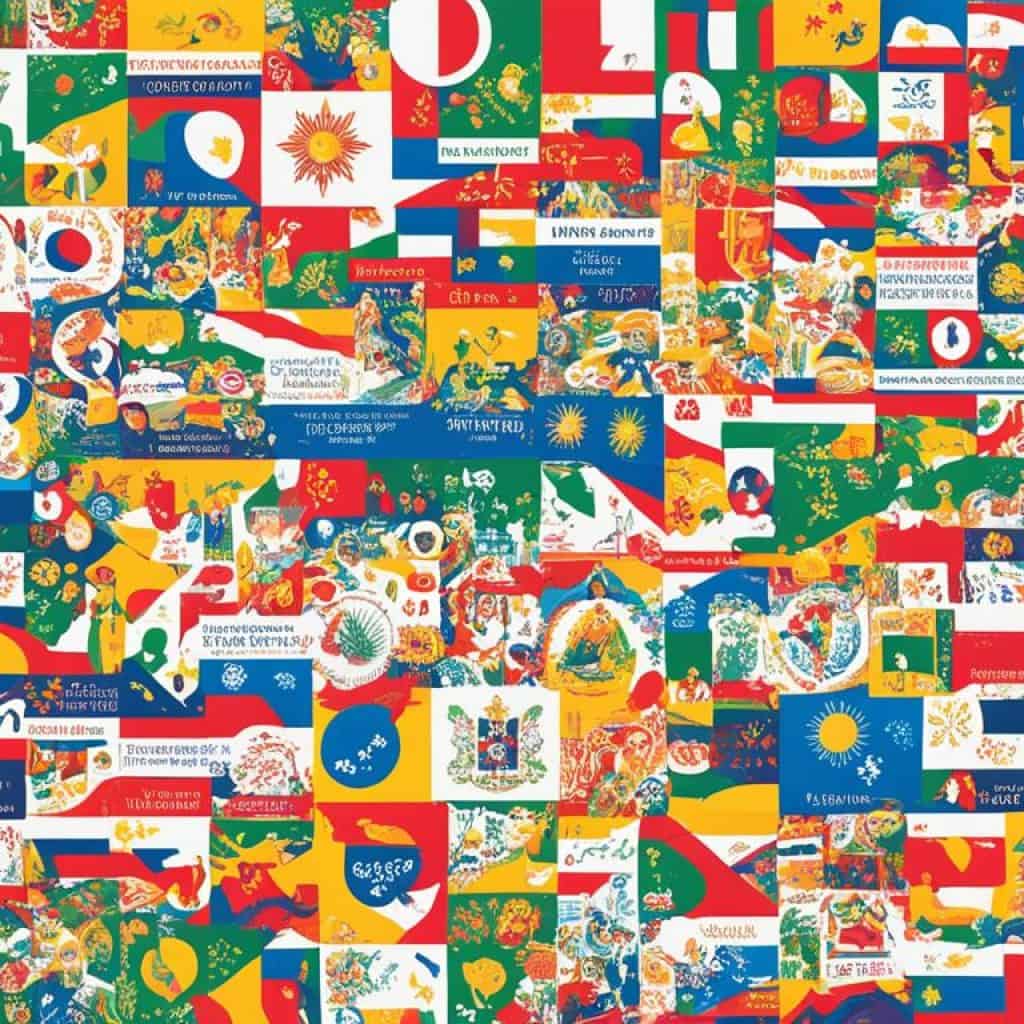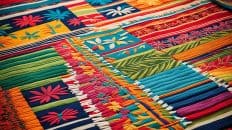Have you ever thought about where the Tagalog language came from? It has evolved over thousands of years. This evolution made it a key part of Filipino culture. Let’s explore the interesting history and cultural impact of Tagalog. We’ll see how various influences shaped this famous language.
Key Takeaways:
- Tagalog, a cornerstone of Filipino identity, has evolved over thousands of years.
- The Austronesian expansion played a significant role in the development of the Tagalog language.
- Diverse Austronesian languages in the Philippines highlight the linguistic complexity of the region.
- The Baybayin script and Spanish colonization have left lasting influences on the Tagalog language.
- Tagalog’s resilience and adaptability contribute to its role as a unifying force in Filipino society.
The Austronesian Origins of the Tagalog Language
The Tagalog language comes from the Austronesian family. This group includes languages from Southeast Asia and the Pacific Islands. The Austronesian people moved from Taiwan to the Philippines 2,000 to 3,000 years ago. This was an important moment in the area’s history.
In the Philippines, the Austronesian people introduced their language, traditions, and ways of life. The Tagalog language has changed over time. It was shaped by its own experiences and those of other communities around it.
This migration and the growth of the Tagalog language created a unique cultural and linguistic identity. The roots of Tagalog in the Austronesian history are central to the Philippines’ rich language story.
Over many years, Tagalog has grown, taking in new influences from other languages and cultures. From its early days to now, Tagalog is a key part of what it means to be Filipino. It’s also the national language of the Philippines.
The Role of the Austronesian Language Family
More than 1,200 languages, including Tagalog, belong to the Austronesian family. They’re spoken by many across Southeast Asia and the Pacific. They started in Taiwan and spread through sea travel, reaching many islands.
These languages are alike in many ways and come from the same original language. The Austronesian people’s travels brought not just language changes but also cultural sharing that connected different communities.
Knowing about Tagalog’s Austronesian roots helps us understand its history and cultural impact. It shows how the language and Filipino identity have been shaped.
“The Austronesian migration to the Philippine archipelago marked a significant milestone in the history of the Tagalog language, forming its foundation and paving the way for its remarkable development.”
A Shared Cultural Heritage
Being part of the Austronesian family links the Philippines with cultures and languages across the region. This is clear in Tagalog’s words, grammar, and traditions.
The Austronesian roots of Tagalog help us see the ties between Filipino communities and others. This understanding helps us appreciate the Philippines’ diverse languages and cultures.
The Influence of Austronesian Languages in the Philippines
The Austronesian arrival impacted Tagalog and other local languages. Languages like Cebuano, Ilocano, and Hiligaynon have flourished, each with its own culture.
These languages show how the Philippines’ various communities have interacted over centuries. Although the languages are different, they share common Austronesian features.
Tagalog’s Austronesian roots and its relationship with other local languages underline the unity among Filipino communities. They also connect the Philippines to the broader Southeast Asian and Pacific landscape.
| Austronesian Language Family | Languages Spoken in the Philippines |
|---|---|
| Tagalog | Tagalog |
| Cebuano | Cebuano, Boholano, Waray-Waray |
| Hiligaynon | Hiligaynon, Kinaray-a, Aklanon |
| Ilocano | Ilocano |
Diverse Austronesian Languages in the Philippines
As Austronesian settlers spread in the Philippines, they met different indigenous groups. This led to many Austronesian languages in the area. The Philippines’ language diversity shows the complexity of Austronesian and local impacts. Today, we see many regional languages and dialects, including versions of Tagalog.
| Language | Location | Main Characteristics |
|---|---|---|
| Tagalog | Mainland Luzon | The standard language in the Philippines and the basis for Filipino, heavily influenced by Spanish and English. |
| Kapampangan | Pampanga and Tarlac provinces | Known for its culinary heritage, Kapampangan shares similarities with other Central Luzon languages. |
| Ilokano | Ilocos Region | One of the most widely spoken regional languages, recognized for its distinct pronunciations and vocabulary. |
| Cebuano | Visayas and parts of Mindanao | The second most widely spoken language in the Philippines, with significant variations across different regions. |
| Hiligaynon | Western Visayas | Known for its poetic qualities and is often referred to as “Ilonggo.” |
The regional languages and dialects in the Philippines show a rich language tapestry. They highlight various influences that shaped language in the country. Each language and dialect gives us a glimpse into the vibrant Southeast Asian linguistics in the Philippines.
Baybayin – The Ancient Script of the Tagalog People
The Tagalog culture is closely linked with Baybayin, their unique writing system. This script was crucial for recording events, preserving culture, and for art. It was developed by the Tagalog people.
Baybayin was used for storytelling. It helped keep Tagalog history and traditions alive across generations. This script made it easy to share complex ideas and cultural details.
Using Baybayin, the Tagalog inscribed their beliefs and achievements on bamboo, palm leaves, and bark. These writings became a treasure trove of knowledge, showing their society’s richness.
Baybayin helped make Tagalog a distinct language. It influenced how the language evolved, including its vocabulary, grammar, and syntax.
The Baybayin script was a testament to the creativity and ingenuity of the Tagalog people. It allowed them to express their unique cultural identity and contribute to the rich tapestry of Philippine history.
Spanish colonization, however, brought big changes to the Tagalog writing system. The Latin alphabet was introduced, slowly taking over Baybayin’s place. Still, the importance and legacy of Baybayin remain in the hearts of Filipinos.
| Key Points | Details |
|---|---|
| Origins | The ancient script of Baybayin was developed by the Tagalog people to record significant events and preserve cultural knowledge. |
| Cultural Importance | Baybayin played a vital role in shaping Tagalog culture and identity, allowing for the expression of artistic endeavors. |
| Medium of Communication | The use of Baybayin helped the Tagalog people communicate complex ideas and concepts, capturing the nuances of their language and culture. |
| Influence on Language | The usage of Baybayin contributed to the development of Tagalog as a distinct language, influencing vocabulary, grammar, and syntax. |
| Transition | Spanish colonization introduced the Latin alphabet, leading to the gradual decline of Baybayin’s usage in favor of the new writing system. |
Spanish Colonization and the Influence on Tagalog
The Spanish took over the Philippines in the 1500s. They left a big mark on the Tagalog language. When they came, they brought their language to show their power. This made Tagalog rich with Spanish words and phrases.
Tagalog’s way of forming sentences changed because of Spanish rules. This made Tagalog look a bit like Spanish. A unique blend of Tagalog now reflects both native and Spanish elements.
Spanish rule also changed how Tagalog was written. The Baybayin script was replaced by the Latin alphabet. This change made writing in Tagalog easier and helped spread ideas.
Today, you can still see the Spanish impact on Tagalog. Many Spanish words are used every day, adding to Tagalog’s variety. This shows the deep connection between the Philippines and the Spanish-speaking world.
Explore below an illustration showcasing the linguistic influences in Tagalog:
Linguistic Influences in Tagalog
| Spanish | Tagalog |
|---|---|
| amigo | kaibigan |
| calle | daan |
| bahía | baybayin |
| dulce | matamis |
The influence of Spanish colonization on Tagalog has left a lasting legacy. It has shaped its vocabulary, grammar, and writing system. This history shows how the Philippines and the Spanish-speaking world are connected.
Chavacano – A Mix of Spanish and Tagalog
Chavacano is a unique Creole language born from the mix of Spanish and local languages in the Philippines. It mainly grew in places like Cavite, blending Spanish with native languages such as Tagalog and Visayan. This language reflects the Philippines’ rich multicultural heritage, showing various regional differences.
Chavacano has stayed alive through many changes, marking an important part of the Philippines’ culture. It shows the Filipino people’s ability to keep their unique identity over time.
“Chavacano is a bridge between Spanish and Tagalog, reminding us of the historical ties and linguistic influences that have shaped the Philippines’ language landscape.”
Chavacano has evolved by mixing Spanish and Tagalog, creating a special mix of words, grammar, and sentence structure. This evolution highlights the deep historical and linguistic connections between the Philippines and the Spanish world.
The Importance of Chavacano
Chavacano helps keep the Philippines’ language and culture diverse. It connects people to the country’s history under Spanish rule. By valuing Chavacano, the Philippines celebrates its many cultures and the significance of different languages.
Chavacano also helps people from Spanish and Filipino backgrounds communicate and feel connected. It helps bridge cultural gaps and create a sense of belonging.
The Resilience of Chavacano
Despite changing languages and cultures, Chavacano is still strong in various parts of the Philippines. It keeps changing, absorbing new influences while holding on to its Spanish roots.
The language has lasted thanks to the communities who have passed it down through generations. Efforts to celebrate Chavacano in books, music, and schools also help keep it alive.
Chavacano: A Cultural Treasure

Chavacano serves as a bridge between Spanish and Tagalog, representing the synthesis of cultures and histories that make up the Filipino identity.
Chavacano is more than a language; it’s a symbol of the Filipino spirit of resilience and adaptability. Acknowledging Chavacano’s role enriches our understanding of the Philippines’ diverse languages. It stresses the need to celebrate and protect the unique languages that shape the nation.
The Emergence of Filipino as a National Language
In the early 20th century, the Philippines started a journey. Its goal was to find a national language to unite and preserve its culture. Tagalog became the choice for this language in 1937. This step was key in developing the Filipino language.
The Filipino language evolution began with tagalog. It has been shaped by many influences in Tagalog over time. Yet, the Philippines has many regional languages. These languages are still vital to its cultural identity.
“Language embodies the culture, customs, and traditions of a people. By establishing a national language, the Philippines aims to preserve its unique heritage while fostering a sense of belonging among its diverse population.”
Tagalog was chosen because many people across the islands already spoke it. But, Tagalog’s history goes back to Austronesian roots. It also includes influences from Spanish and English.
Tagalog Language Origin
The tagalog language origin starts with the Austronesian family. It connects languages across Southeast Asia and the Pacific. The Austronesian people, including Tagalog ancestors, moved to the Philippines around 2,000 to 3,000 years ago. They set the stage for Tagalog’s development.
As Austronesian settlers spread, they met local groups. This led to many Austronesian languages in the Philippines. This mix shows the complex roots and local impacts that enrich the Philippines.
Linguistic Influences in Tagalog
The Philippines’ languages show a mix of many cultures. Spanish rule brought major changes in Tagalog. It added Spanish words and changed grammar and syntax.
Later, English, brought by Americans in the 20th century, also influenced Filipino. It added new words and phrases to Tagalog. This expanded its vocabulary.
| Language | Period | Influence |
|---|---|---|
| Spanish | 16th to 19th century | Lexicon and grammar |
| English | 20th century to present | Vocabulary and expressions |
These influences show how the Filipino language can adapt. It incorporates different cultural elements. This makes it a true mirror of the Philippines’ rich history.
The Complexity of the Linguistic Landscape in the Philippines
The Philippines is a fascinating place for anyone interested in languages. It has over 120 to 175 different languages and dialects. This makes it one of the most linguistically diverse places in the world. The many languages spoken here show the country’s rich culture and history.
Tagalog is the national language and is very important for communication and education. But local languages and dialects are also thriving across the islands. Languages like Cebuano, Ilocano, and Hiligaynon are spoken with great pride by local people.
“The linguistic diversity in the Philippines is a true reflection of our cultural tapestry, showcasing the interconnectedness of our various communities and their distinct identities.” – Dr. Maria Santos, Linguistics Expert
Regional languages and dialects add to the country’s cultural richness. They keep alive unique local expressions and ways of speaking. This diversity not only highlights the rich culture of the Philippines but is also key to its social bonds.
The Role of Language in Cultural Identity
Language helps us understand and appreciate different cultures. It carries traditions, stories, and histories through the generations. Celebrating linguistic diversity means recognizing how important culture and identity are.
Efforts to keep indigenous languages alive are strong in the Philippines. Cultural organizations and schools are working hard to document and teach these languages. Language schools and community initiatives are crucial for keeping these languages alive for future generations.
The Tagalog Language and Cultural Heritage
Tagalog plays a special role in the Philippines. It connects different regions and ethnic groups. The way Tagalog has grown and changed shows the dynamic culture of the country and how it embraces various influences.
Preserving Linguistic Diversity
While Tagalog is central to Filipino identity, regional languages are also important. They are not just dialects; they reflect the unique cultures, histories, and identities of different groups. By supporting these languages, the Philippines keeps its linguistic heritage vibrant and inclusive. It also builds pride and respect for all languages in the Filipino cultural mosaic.
The Significance of Tagalog in Modern Filipino Society
Tagalog is at the heart of Filipino identity. It’s vital in government, education, media, and daily chat. It unites Filipinos everywhere.
Tagalog’s use in media like TV and movies connects Filipinos. It entertains and expresses culture. This strengthens national pride and belonging.
“**Tagalog remains at the heart of the Filipino national identity.**”
Tagalog’s journey from its ancient roots to today’s unifying language shows the Filipino spirit. It has grown through history, absorbing many influences. Today, it stands as a symbol of the Philippines’ spirit and identity.
The Role of Tagalog in Government and Education
Tagalog plays a key role in Philippine government operations. It’s used in official paperwork and government dealings. This promotes cultural identity and makes government more accessible.
In education, Tagalog is crucial. It helps shape young minds and preserves the linguistic heritage. Teaching Tagalog connects Filipino students to their roots and culture.
The Influence of Tagalog in Media
The media landscape in the Philippines thrives on Tagalog. Shows, films, and music are mostly in Tagalog. This lets artists connect with more Filipinos and share cultural stories.
Tagalog’s media influence reaches Filipinos worldwide. This keeps overseas Filipinos linked to their homeland. It fosters cultural unity and belonging.
The Language of Everyday Communication
For daily talks, Tagalog is key among Filipinos of different regions. Despite many regional languages, Tagalog is the bridge for effective communication across the nation.
In both cities and villages, Tagalog underpins social life. It aids trade, fosters friendships, and unites Filipinos. It ensures meaningful connections are made.
| Key Points | Description |
|---|---|
| Cultural Heritage | Tagalog reflects the rich cultural heritage of the Philippines, incorporating linguistic influences from various historical and contemporary sources. |
| Unifying Force | Tagalog serves as a unifying language, fostering a sense of national identity and pride among the Filipino people. |
| Government and Education | Tagalog is the language of governance and plays a vital role in the educational system, preserving the country’s linguistic heritage. |
| Media Influence | The widespread use of Tagalog in media platforms strengthens cultural expression and connects Filipinos globally. |
| Everyday Communication | Tagalog acts as a lingua franca, enabling effective communication among Filipinos from diverse regions and linguistic backgrounds. |
The Influence of Trade and International Relations on Tagalog
The Tagalog language has grown because the Philippines is a big trade hub. Its history with other countries has shaped it.
Filipino language evolution is rich because of the mix of languages from traders and explorers. The linguistic influences in Tagalog show a deep connection to the global community.
Trade has brought new words and ideas from other languages into Tagalog. For example, trade with the Portuguese and Chinese added new commerce terms. Arabic and Sanskrit added to philosophy and religion.
“The linguistic influences in Tagalog reflect the dynamic nature of the language and its adaptability to embrace new ideas and concepts from different cultures.”
Historical interactions have updated Tagalog’s grammar and syntax too. The way sentences are built has been shaped by these changes. This lets speakers share thoughts in new ways.
The linguistic influences in Tagalog also celebrate the Philippines’ diverse culture. It’s a blend of many languages and cultures, making Tagalog a unique and rich language.
The Multicultural Vocabulary of Tagalog
The vast mixture of foreign words in Tagalog shows its absorption of different influences. The table below lists some foreign words in Tagalog:
| Language/Culture | Tagalog Word | Meaning |
|---|---|---|
| Spanish | salapi | money |
| English | kamera | camera |
| Chinese | siopao | steamed bun |
| Arabic | salamat | thank you |
The multicultural vocabulary of Tagalog showcases the language’s constant evolution and its ability to embrace new words as it interacts with different cultures.
Trade and global ties keep influencing Tagalog. With the Philippines involved in global activities, Tagalog keeps changing with the world.
The Importance of Language Preservation in the Philippines
Keeping various languages alive is crucial to honoring Philippine culture. The Constitution highlights the importance of local languages in forming the nation’s identity. Efforts have been put into safeguarding languages like Tagalog, an essential part of the country’s language heritage.
“Language is the key to understanding a people’s history, values, and traditions. By preserving our languages, we ensure the continuity of our cultural heritage for future generations to appreciate and embrace.”
Preserving languages is more than saving words. It’s a celebration of the different dialects that make up the Philippines’ language scene. By protecting languages like Tagalog, we honor the country’s linguistic diversity.
Language changes with society. But preserving it helps us look back at our history. It captures how our ancestors communicated. This gives us insights into our cultural identities and the link between language and heritage.
In the Philippines, we’re keeping our language traditions alive through various means. Educational efforts, cultural programs, and projects revive languages. This ensures future generations can connect with their ancestral languages, strengthening their identity.
The Enduring Legacy of Linguistic Diversity
The Philippines’ language wealth goes beyond borders, touching lives across ages. It’s found in art, music, and daily life, expressing love and belonging. Keeping this language diversity alive lets these unique voices continue to shape our culture.

The Intersection of Language and Culture
Language and culture are deeply linked. They reflect a society’s customs, beliefs, and principles. By keeping languages like Tagalog alive, we support the cultural environment they grow in. This helps pass down folklore and wisdom, protecting our shared heritage.
Language preservation shows the Filipino spirit’s strength and dedication. It symbolizes our commitment to maintaining the special voices that define our culture. Through our efforts, we ensure the Filipino legacy remains vivid and impactful for future generations.
Valuing linguistic diversity helps us appreciate our heritage more deeply. It strengthens our national unity. The work to save Tagalog and other local languages keeps our cultural history vibrant and meaningful, inspiring future generations.
The Resilience of Language in the Philippines
The Filipino people are great at adapting. They have brought different influences into their language. This shows how languages in the Philippines are resilient. Despite colonization and globalization, languages like Tagalog keep growing. They change but still show the country’s rich culture. The Filipino people’s dedication to their culture is clear in how they maintain their language.
The history of the Tagalog language is fascinating. It has changed a lot over time due to outside influences. Starting with its roots in Austronesian languages to changes from Spanish and American presence. Despite all this, Tagalog has kept its core. It now reflects the Philippines’ diverse cultures beautifully.
“Language is the road map of a culture. It tells you where its people come from and where they are going.” – Rita Mae Brown
The Evolution of Filipino Language
The Filipino language has grown a lot. It started with Tagalog and has had many influences. Now, as the national language, Filipino brings people together. It helps keep the culture strong. Filipino shows how the language can grow and stay strong through changes in society and history.
The Cultural Heritage of Tagalog
Tagalog is very important to the Filipino people. It carries their history, traditions, and experiences. It’s how they express their culture and keep it alive. The importance of Tagalog in Filipino culture is huge. It helps keep their identity rich and diverse.
| Language Influence | Description |
|---|---|
| Spanish Colonization | Spanish colonization brought Spanish words into Tagalog, changing its vocabulary a lot. |
| America’s Influence | The American presence led to English words being added, which made Tagalog even more diverse. |
| Indigenous Cultural Influences | Meeting with different indigenous groups in the Philippines added more variety to Tagalog and other languages. |
Tagalog has faced many changes but keeps growing. It’s a source of pride for Filipinos. They celebrate their culture through their evolving language. This shows the amazing resilience of Tagalog and the Filipino people.
The Role of Education in Language Preservation
Education is key in keeping languages alive in the Philippines. It introduces regional languages, such as Tagalog, into schools. This helps students appreciate their language heritage. Future generations learn to keep their cultural languages alive, like Tagalog. This adds to the country’s rich language mix.
The Filipino language has a unique story. It started with Austronesian roots and took in different cultural influences over time. Education helps us see how the Filipino language has changed and grown.
“Language is the road map of a culture. It tells you where its people come from and where they are going.” – Rita Mae Brown
Teaching languages is crucial for preserving the Philippines’ linguistic heritage. Students who learn about the history, grammar, and syntax of languages like Tagalog gain a deeper respect for their culture. They understand how language ties to culture and society. This builds pride and identity.
Education is important for keeping the variety of languages in the Philippines alive. By learning about languages like Tagalog, people become advocates for their language. They promote the use and value of Tagalog and other local languages.
Bringing language preservation efforts into schools helps connect different generations. Sharing the value and knowledge of languages like Tagalog helps the next generations. They can keep their cultural languages growing and alive.
The Benefits of Language Education in the Philippines
Language learning in the Philippines offers many benefits for people and society:
- Promotes Cultural Identity: Language education strengthens connections to culture and identity among Filipinos.
- Fosters Intercultural Understanding: Learning many languages helps us understand and live together in a diverse world.
- Improves Communication Skills: Learning languages boosts communication skills, including in native and other languages.
- Opens Opportunities: Knowing many languages creates more job chances at home and abroad.
- Preserves Linguistic Diversity: Teaching regional languages like Tagalog keeps the country’s language diversity alive.
Education’s role in language preservation is clear in the Philippines. It helps protect the language heritage of the country. Through language education, the next generations will keep the cultural wealth and diversity of the Filipino identity alive.
The Ongoing Evolution of Tagalog
Tagalog is a living language, always changing to meet its speakers’ needs. It has evolved into Filipino, showing how dynamic it is. It can take in new words from different sources.
The story of Filipino language growth is thrilling. It shows the Filipino people’s strength and inventiveness. They face a fast-changing world head-on. Tagalog has borrowed from many cultures over time, making its vocabulary rich and varied.
Tagalog Language Development
Tagalog’s roots go back to the Austronesian people who arrived in the Philippines long ago. As it evolved, Tagalog mingled with local languages. This brought about various dialects.
When Spain colonized the Philippines in the 16th century, Tagalog changed a lot. Spanish words became part of Tagalog. The Latin alphabet also replaced the old Baybayin script.
Linguistic Influences in Tagalog
Then, the American era added English to Tagalog’s influences in the early 20th century. English words started appearing in everyday Tagalog talks. This mix of Spanish, English, and Tagalog made a unique language. It reflects the nation’s history and culture.
“Tagalog’s growth shows how society keeps changing and innovating. As new tech and ideas come up, Tagalog adds them to its vocabulary.”
Tagalog’s growth keeps it relevant today and worldwide. As tech and global connections grow, Tagalog stays a vivid symbol of Filipino resilience and flexibility.
Tagalog keeps evolving, making it a pride source and key expression tool for many Filipinos. Its dynamic nature mirrors the Philippines’ diverse and changing scenery. It connects people to their heritage.
The Global Reach of the Tagalog Language
The Tagalog language has a rich history. It has influences from many cultures. This language has crossed borders and is recognized globally.
Tagalog is used by Overseas Filipino Workers (OFWs) around the world. They use it to communicate beyond the Philippines.
Tagalog, also known as Filipino, is one of the most spoken languages. It’s heard from New York City to Los Angeles. Filipinos abroad keep their language and culture alive.
“Tagalog is not just a language; it is our connection to home. It shows who we are as Filipinos.”
– Maria Santos, OFW in Dubai
Tagalog’s international presence is significant. It connects Filipinos globally. It is used in music, films, literature, and social media. This preserves their culture and brings them together.
The interest in Tagalog goes beyond the Filipino community. Language lovers and travelers are drawn to its beauty. This boosts its global presence.
Tagalog is growing and adapting over time. Its global reach shows its strength and influence. It’s a language of unity and pride.
The Influence of Tagalog
Tagalog’s influence is wide. It affects music, fashion, food, and entertainment globally. Vibrant Tagalog music and dance have won hearts worldwide.
Tagalog food is gaining fame for its unique taste. Dishes like adobo and pancit are loved far and wide. They introduce people to Tagalog culture.
Tagalog films and TV are making international waves. They share Filipino stories with more people. This promotes understanding and appreciation between cultures.
Tagalog’s global reach is increasing. It highlights the language’s role in connecting and uniting people. It celebrates the Philippines’ culture in the global community.
Conclusion
The origin and growth of the Tagalog language highlight the Philippines’ rich culture. This language has roots in ancient Austronesian traditions. Plus, it has been shaped by Spanish and American influences. Today, Tagalog reflects the dynamic diversity of the Filipino culture.
As the national language, Tagalog holds the country’s cultural identity together. It plays a key role in uniting the nation. This showcases the important part language plays in national unity.
Tagalog’s history shows its strong spirit. It has developed over thousands of years, embracing different linguistic changes. More than just a way to talk, Tagalog symbolizes the Philippines’ shared past and heritage.
Globally, Tagalog has made its mark thanks to the Filipino diaspora. The language’s ongoing change demonstrates the Filipino spirit of resilience and innovation. It connects Filipinos worldwide while keeping their cultural legacy alive for future generations.







Add comment